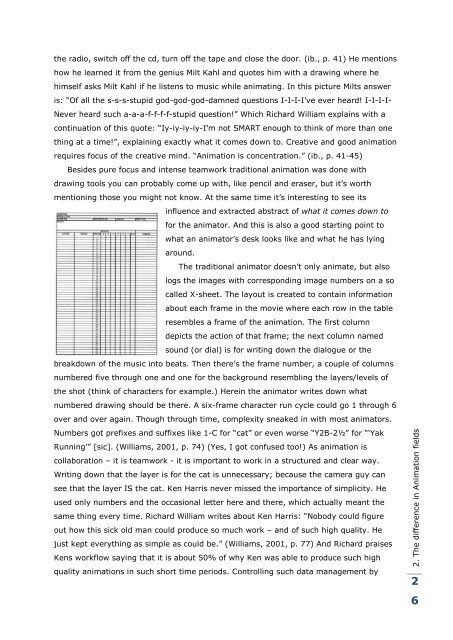Release. Pressure. Animate.
Release. Pressure. Animate.
Release. Pressure. Animate.
Create successful ePaper yourself
Turn your PDF publications into a flip-book with our unique Google optimized e-Paper software.
the radio, switch off the cd, turn off the tape and close the door. (ib., p. 41) He mentions<br />
how he learned it from the genius Milt Kahl and quotes him with a drawing where he<br />
himself asks Milt Kahl if he listens to music while animating. In this picture Milts answer<br />
is: “Of all the s-s-s-stupid god-god-god-damned questions I-I-I-I‟ve ever heard! I-I-I-I-<br />
Never heard such a-a-a-f-f-f-f-stupid question!” Which Richard William explains with a<br />
continuation of this quote: “Iy-iy-iy-iy-I‟m not SMART enough to think of more than one<br />
thing at a time!”, explaining exactly what it comes down to. Creative and good animation<br />
requires focus of the creative mind. “Animation is concentration.” (ib., p. 41-45)<br />
Besides pure focus and intense teamwork traditional animation was done with<br />
drawing tools you can probably come up with, like pencil and eraser, but it‟s worth<br />
mentioning those you might not know. At the same time it‟s interesting to see its<br />
influence and extracted abstract of what it comes down to<br />
for the animator. And this is also a good starting point to<br />
what an animator‟s desk looks like and what he has lying<br />
around.<br />
The traditional animator doesn‟t only animate, but also<br />
logs the images with corresponding image numbers on a so<br />
called X-sheet. The layout is created to contain information<br />
about each frame in the movie where each row in the table<br />
resembles a frame of the animation. The first column<br />
depicts the action of that frame; the next column named<br />
sound (or dial) is for writing down the dialogue or the<br />
breakdown of the music into beats. Then there‟s the frame number, a couple of columns<br />
numbered five through one and one for the background resembling the layers/levels of<br />
the shot (think of characters for example.) Herein the animator writes down what<br />
numbered drawing should be there. A six-frame character run cycle could go 1 through 6<br />
over and over again. Though through time, complexity sneaked in with most animators.<br />
Numbers got prefixes and suffixes like 1-C for “cat” or even worse “Y2B-2½” for “„Yak<br />
Running‟” [sic]. (Williams, 2001, p. 74) (Yes, I got confused too!) As animation is<br />
collaboration – it is teamwork - it is important to work in a structured and clear way.<br />
Writing down that the layer is for the cat is unnecessary; because the camera guy can<br />
see that the layer IS the cat. Ken Harris never missed the importance of simplicity. He<br />
used only numbers and the occasional letter here and there, which actually meant the<br />
same thing every time. Richard William writes about Ken Harris: “Nobody could figure<br />
out how this sick old man could produce so much work – and of such high quality. He<br />
just kept everything as simple as could be.” (Williams, 2001, p. 77) And Richard praises<br />
Kens workflow saying that it is about 50% of why Ken was able to produce such high<br />
quality animations in such short time periods. Controlling such data management by<br />
2. The difference in Animation fields<br />
2<br />
6


